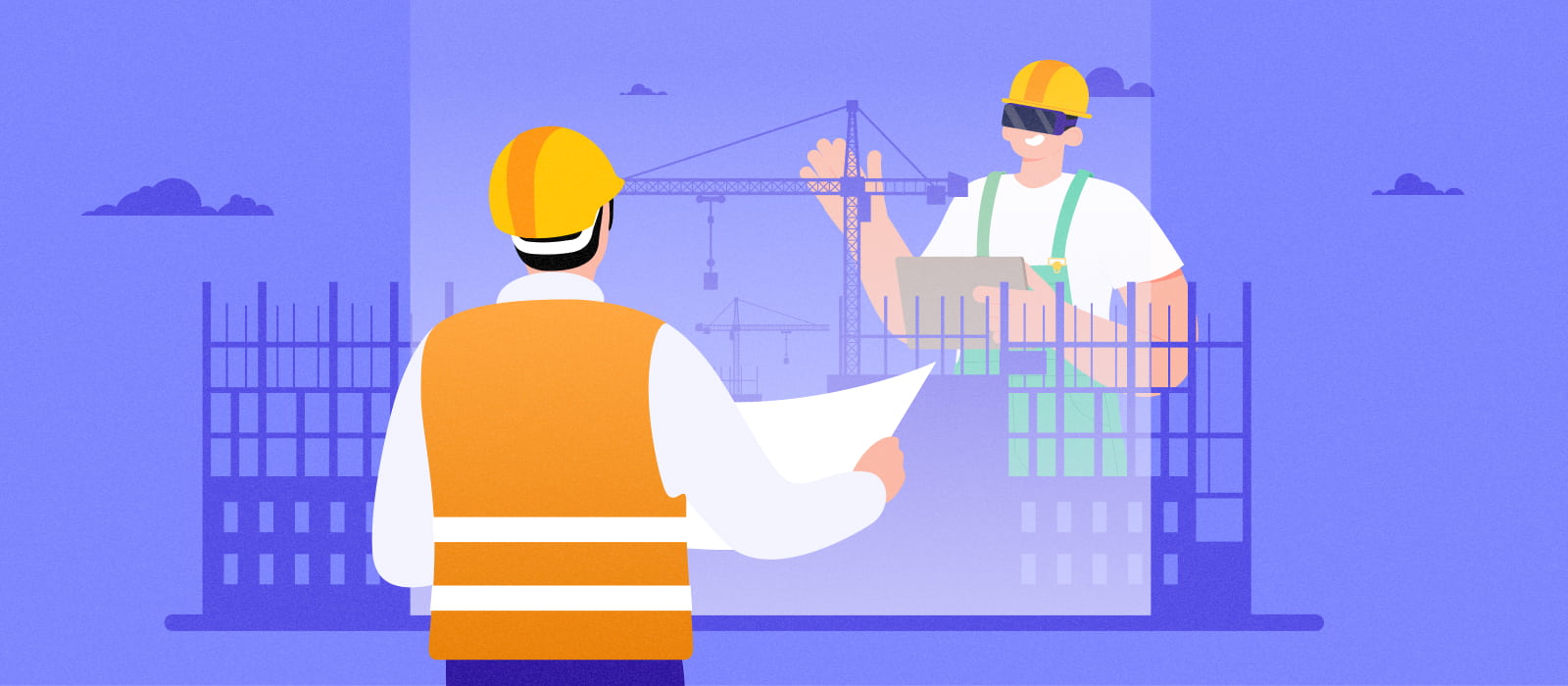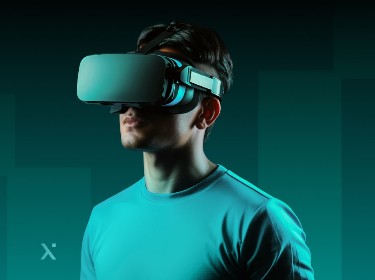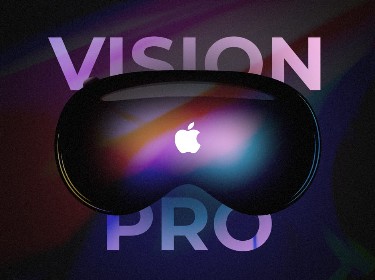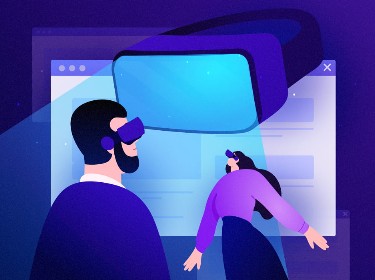Even though innovation has played a major role in the progress of the construction industry, companies have been slow to adopt new technologies. Can the arrival of augmented and virtual reality buck this trend and, most importantly, what will happen as a result?
Augmented and virtual reality (AR/VR) allows architects to take their designs to a whole new plane, opening up far-reaching opportunities for the construction industry.
According to current projections, worldwide construction spending will reach $15.5 trillion by 2030. By 2028, when its market share is expected to reach $250 billion, AR/VR technology could completely change the entire market.
Meanwhile, the newest AR/VR technologies can cut building costs by up to 90% and save the construction industry up to $15.8 billion through preventing mistakes caused by insufficient or inaccurate data.
The building industry has made steady advances toward more technologically advanced processes. AR and VR are built on top of existing technologies to give construction teams more information and help them plan better.
Read on to learn more about how AR/VR technology can be used in the construction industry and improve its workflows.
What are the pros and cons of AR/VR in construction?
Construction companies that successfully adopt and integrate new technologies gain a competitive edge. That’s why AR/VR technology has the potential to take innovators to the next level. However, AR/VR needs to gain traction before we see it in wider use. Let’s now look at these tools’ main benefits and drawbacks.
As for benefits, leveraging AR/VR tools for the construction market can:
- Lower development costs and reduce time
Construction companies can employ AR/VR technology to plan a project from beginning to end, streamline the processes involved in most building projects, and decrease guesswork, thus saving time and money while providing substantial design insights to clients and architects, and ensuring that everyone is on the same page.
- Enable training safety
The construction sector operates in a high-risk field, but thanks to VR-based training solutions, professionals can recreate real-life events in a fully immersive, risk-free environment.
- Improve collaboration and communication
VR tools ensure a more transparent project development process and more productive partnerships.
At the same time, there are still some limitations:
- Weather-sensitive equipment and static environment
Equipment is frequently exposed to adverse weather and performs best when the environment remains largely unchanged.
- The need for strong internet connection
While augmented reality apps can work offline, real-time collaboration won’t be possible without the internet.
- The necessity of learning curve
A new application like AR comes with a learning curve that may prevent companies from investing in the technology. But with the advent of open-source mobile toolkits for AR, the cost of developing augmented reality apps is decreasing, and small-to-medium businesses have begun to reap the benefits of AR building.
Check out our portfolio of AR/VR-powered applications
How can AR enhance the construction processes?
AR apps can see and interpret the outside world in real-time to project images onto it, bringing outstanding gains for the construction industry.
Furthermore, 3D blueprints help project teams to avoid errors and troubleshoot problem areas before the start of construction work. Teams can quickly understand where everything will be built, from ducting to pipes, columns, windows, and access points. This way, it is easier to make changes before, during, and after the project.
While most projects are still in the planning stages, they are moving on rapidly. Martin Bros is forging ahead with comprehensively simulated construction. Floor plans created via a 3D model that acts as the AR interface is an example of the types of projects that have been in the works since 2016.
How does VR change the construction workflows?
Construction is up against increased demand for building efficiency, putting more pressure on architects and designers to pinpoint potential issues early on in the planning stages of the building process. At the same time, virtual reality technology provides a practical planning and rendering tool. Developers are widely using it to review real 3D realizations of architectural designs.
Using a combination of BIM technology and immersive VR headsets, architects and designers can get a better sense of a space before it physically exists and can therefore better plan out their approach to building it.
Moreover, the technology allows firms to make a more compelling case when bidding for a new project: they can take the stakeholders on a virtual tour of the future space instead of presenting a 2D rendering or a model.
AR/VR in construction: key use cases
Construction is not a single process but a series of stages to go through to complete a project. The VR/AR approach is unique in that it is not confined to a single step or setting, and it can be used to solve the problems faced by a variety of specialists in this sector.
Our virtual and augmented reality software development company collected the most promising use cases of AR/VR in construction. Let’s take a closer look at each.
Project planning/preparation
![]()
The value of AR/VR technology in construction begins in the planning and permission stages. Combined with 3D modeling software and BIM, construction companies can produce detailed, interactive models of building projects and present them to clients from the outset of a project.
It is critical to ensure that your project plan aligns with the stakeholders’ requirements. Morpholio is an example of an app that architects can use to design the project by incorporating CAD in the planning phase.
Monitoring real-time project data
Incorporating all the digital information and documentation of a project with its physical location is one of the significant benefits of using AR technology in construction. The technology can help users to access and visualize data such as the location, style, and type of additions to the building shell, ranging from architectural components such as windows and doors to MEP elements like ducts and pipes.
For on-site crews, the ability to merge all digital information and documentation with their physical view is a game-changer. For example, Microsoft’s HoloLens can display the physical dimensions of a space. This data can then be included in 3D models, allowing for more precise visualization and construction processes. As the industry struggles with productivity, this application will be an indispensable part of project management.
Meet QTS, a real estate platform that presents properties via 360° virtual tours
Streamlining processes
AR/VR technology is proving it can streamline efficiency across the board and throughout different teams during a project. It has taken the concept of 3D modeling to new heights and made it far more accessible. AR and VR models can now be rapidly and easily shared across the team, which boosts collaboration regardless of location.
For instance, with Akular AR, a cloud-based technology, users can view 3D models of physical environments on their smartphone or tablet. In addition, the technology optimizes BIM models and allows users to examine them on-site, enabling team members to send data such as BMS and IoT sensor data in real time.
Ensuring safety and improving workplace safety standards
Safety is paramount, whether we’re talking about workplace protocols or establishing and implementing a quality program. These days, safety protocols and technology are merging to help better equip team members to perform their jobs.
Nevertheless, the construction industry still experiences a significant number of workplace injuries. For example, in the United Kingdom muscular-skeletal injuries account for 57% of accidents.
To this end, developers are finding innovative approaches to improve safety standards. For example, computer prototypes can assist in identifying potential risks before the start of a project. In addition, workers can familiarize themselves with the layout, rigging, and machinery (or tools), and find out how to perform the job effectively and securely inside a simulator.
Creating a clear picture
Specialists can create 3D models of projects using advanced BIM drawings, allowing consumers to tour their new facility even before the ground has been broken. As mentioned, Microsoft’s HoloLens can measure the physical dimensions of space. Companies can then use these models to correctly calculate the dimensions and preview what the completed project will look like.
The greatest benefit of using augmented reality is seeing how features fit on the site.
It allows project managers to visualize how everything slots together, on-site and to scale, before they order materials or calculate the work required for installation.
On-site revision allows architectural discrepancies to be detected. High costs and delays can be avoided by promptly adapting to the changes.
Staff training/safety training
Many jobs in construction involve heavy machinery, which can be dangerous without proper training. With the margin of error so low in many real-world situations, it’s clearly best if workers familiarize themselves with the controls and operations in a safe environment.
Safety programs do, of course, take substantial time and money to implement, but with the help of an AR headset workers can access virtual drills, instructions, and safety scenarios.
CM Labs was recently tasked with creating a VR training simulator for New York City crane operators. The application allowed trainees to familiarize themselves with the enormous machines before trying their hand at the real thing. This method of direct learning not only raises their safety awareness and delivers intuitive training, but it also lowers training expenses and downtime.
Find out more about how AR/VR technologies can assist people with learning and training
Remote maintenance
There are many cases where workers know how to fix an issue but might need some guidance in identifying exactly where the fix is required. AR ensures a project will always have a more experienced technician on call, no matter where in the physical world it is located.
By defining a new approach to work, Arvizio Instructor provides a real-time set of instructions that indicate the actions to be taken by technicians or operators. Additionally, with real-time collaboration, field workers and remote experts share information using video, audio, markups and other tools to assist the field worker.
Thanks to new technology, everything can be done without a site visit (or, in the case of a complicated issue, numerous site visits). This saves organizations time and lowers the risk of errors.
Great team collaboration
Effective communication is critical during the course of a construction project. Virtual reality provides an exciting solution that puts collaborative teams on-site without the need for them to travel to the actual construction area.
AR/VR technology allows remote workers to inspect the job site as if they were there in person. Workers can also use augmented reality to capture notes, images, or videos of problems which, later on, distant teams can review.
For instance, The Wild is a software platform that combines AR with VR to enable collaboration between team members. It will let different teams gain access to a virtual workspace that provides design reviews and creates markups. As a result of the more efficient ways of communicating, users will be able to work on projects remotely.
Simpler project modifications
As discussed, a major step forward driven by augmented reality is the ease with which users are now able to make changes to building models directly on the field site. For project modifications, this means that by using a headset or mobile device (developed by either a custom Android app development company or iOS app development company), any operator can easily display the interior and exterior views of a structure and make modifications to the virtual plans while keeping the original concept intact.
Engineers, for example, will soon be able to digitally remove and relocate structural components and change the plan of a structure with just a few touches on an AR-enabled tablet. This application will be valuable for engineers as it allows them to troubleshoot any errors in a virtual view before applying changes to the physical structure.
Furthermore, since this digital data is continuously updated, it removes the guesswork from project changes while improving workflow and preventing wastage of materials.
Speeding up sales cycle
We’ve already seen how virtual and augmented reality in construction allow for the testing of buildings before they are constructed. This becomes all the more advantageous when you’re dealing with a hundred-million-dollar building project, and your client wants to see how it’s going to work.
VR and AR technology can shorten the sales cycle. For example, a sales team can provide future tenants with a view of how their property should look when the construction is done. In addition, it allows employers to attract prospects by showing the future facilities.
This VR virtual tour solution allows hotel owners to showcase locations with the Oculus Go headset
Installation process and equipment monitoring
![]()
Unlike manufacturing, a typical construction project includes a great deal of documentation and continuous changes. Construction is constantly evolving. AR technology allows for a model-based construction that would allow development to happen within shorter time frames.
Of course, there is a lot of equipment on any building site as well. AR tools can help to identify where those machines are and how they are being used at any given time. Furthermore, sharing equipment between divisions becomes readily achievable.
Labor shortage prevention
The shortage of trained personnel in the construction industry is well-documented. Young workers are stepping forward, but not at a fast enough rate to replace seasoned industry veterans who have opted for retirement.
With new technologies, the industry hopes to attract digitally native young workers. Young people today are more comfortable with advanced technology than prior generations because they have grown up with it.
Incorporating VR/AR into training and real-world construction work could help attract the sort of young people who would be naturally drawn to high-tech fields.
Real-life examples of using AR/VR in construction
We’ve already mentioned some of the current applications at the forefront of this revolution, but now we’ll have a closer look at the most interesting case studies.
DAQRI Smart Helmet
The DAQRI Smart Helmet is a helmet capable of visualizing projects and 3D models in augmented reality as an immersive and large-scale 3D environment. Teams can compare work-in-progress to the original design and thus improve work accuracy.
Dalux
Dalux, on the other hand, provides three augmented reality civil construction solutions.
The Dalux Viewer is a free iOS and Android application that allows users to develop a 3D model and digital drawings on the actual construction site.
Dalux Build integrates augmented reality with other tools to make it easier to manage building projects, providing a constant flow of data.
DaluxFM, for its part, provides solutions for facility management, such as planning and asset management, as well as contracts for outsourced and associated services, electrical maintenance, hydraulics, rent control, and site preservation activities.
Fologram
Fologram uses augmented reality glasses like the HoloLens to turn 3D models into full-size construction instructions. The program aims to facilitate the construction of complex projects that require a series of measurements, verification, and specific care through digital instructions that are virtually superimposed on the workspace, guiding masons step-by-step during the construction process.
New Rochelle
New Rochelle, a mid-sized community in New York, had its downtown area regeneration program enhanced by a virtual reality platform that allowed users to see about 3 million square feet of changes and renovations in 360-degree views.
In addition, the city planners received comments on the various proposed changes by making the experience available to residents on headsets and mobile devices.
Nova
Nova is a large hospital in Finland that brings together primary health care, special health care, and social services. The company behind the project created a VR experience based on BIM, which had a big impact on the rollout of the scheme.
For example, the design was made available to hospital staff, who then offered feedback and suggestions for changes. The technology also allowed hospital staff to familiarize themselves with their new workplace beforehand, easing their transition.
Learn more about what WebAR is and why businesses are interested in it
Future of AR/VR in construction
When it comes to the evolution of the construction industry, investment in AR/VR-based technologies can no longer be seen as a minor add-on. AR/VR innovations have the potential to become integral to the sector, especially in light of external shocks such as COVID-19, which showed how important it is to be able to incorporate digital solutions and to operate remotely.
Although only large construction businesses have fully upgraded to AR/VR so far, as the technology becomes more affordable and 5G networks expand we’ll see the industry becoming ever more dynamic and competitive.
However, the path to AR/VR advancements in construction requires a partner such as PixelPlex — in other words, a team with a thorough understanding of these technologies and a firm belief that AR/VR is ready-made for 3D construction modeling.
PixelPlex specialists bring a wealth of experience in AR/VR technology development.
We can be your guide to the industry’s immense growth possibilities, all the while keeping close tabs on the specific demands of your project. Furthermore, we can assist you with metaverse development, building even more immersive experiences and simulations. So if you’re interested in building an exciting future, reach out to us and start your digital transformation now.




